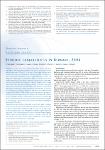Epidemic conjunctivitis in Germany, 2004
Schrauder, Annette
Altmann, Doris
Laude, Gabriele
Claus, Hermann
Wegner, K
Köhler, R
Habicht-Thomas, H
Krause, Gérard
Epidemic conjunctivitis can be associated with viral or bacterial pathogens, whereas epidemic keratoconjunctivitis is caused mainly by adenoviruses type 8,19 and 37. In Germany, the incidence of adenovirus conjunctivitis cases increased from 0.2 per 100 000 inhabitants (in 2001 and 2002) eventually to 0.5 in 2003 and 0.8 in 2004. The detection of adenovirus in conjunctival swabs is notifiable to the local health departments. Data about cases with positive conjunctival swabs are then transmitted to the Robert Koch-Institut. Quality control of data takes place and national surveillance data of confirmed cases with adenovirus conjunctivitis are published. From January to April 2004 the national surveillance system captured an outbreak with 1024 cases (131 laboratory confirmed). Analysis of the national surveillance data showed that in March 2004 the group primarily affected by epidemic keratoconjunctivitis was young men between 18 -29 years old followed by an increased number of notifications from women in the same age group. Meanwhile the German Armed Forces experienced an outbreak of conjunctivitis, almost exclusively without laboratory confirmation, affecting 6378 soldiers. Despite the small number of laboratory confirmed cases it became clear from the analysis of the national surveillance data that person-to-person transmission between young men and similar age groups of the population did occur. Whether the outbreak started within the garrisons of the German Armed Forces or whether it was triggered within these accommodations, there is clearly a need for the national and the military public health institutions to work together on guidelines to handle future challenges.
Dateien zu dieser Publikation
Keine Lizenzangabe

